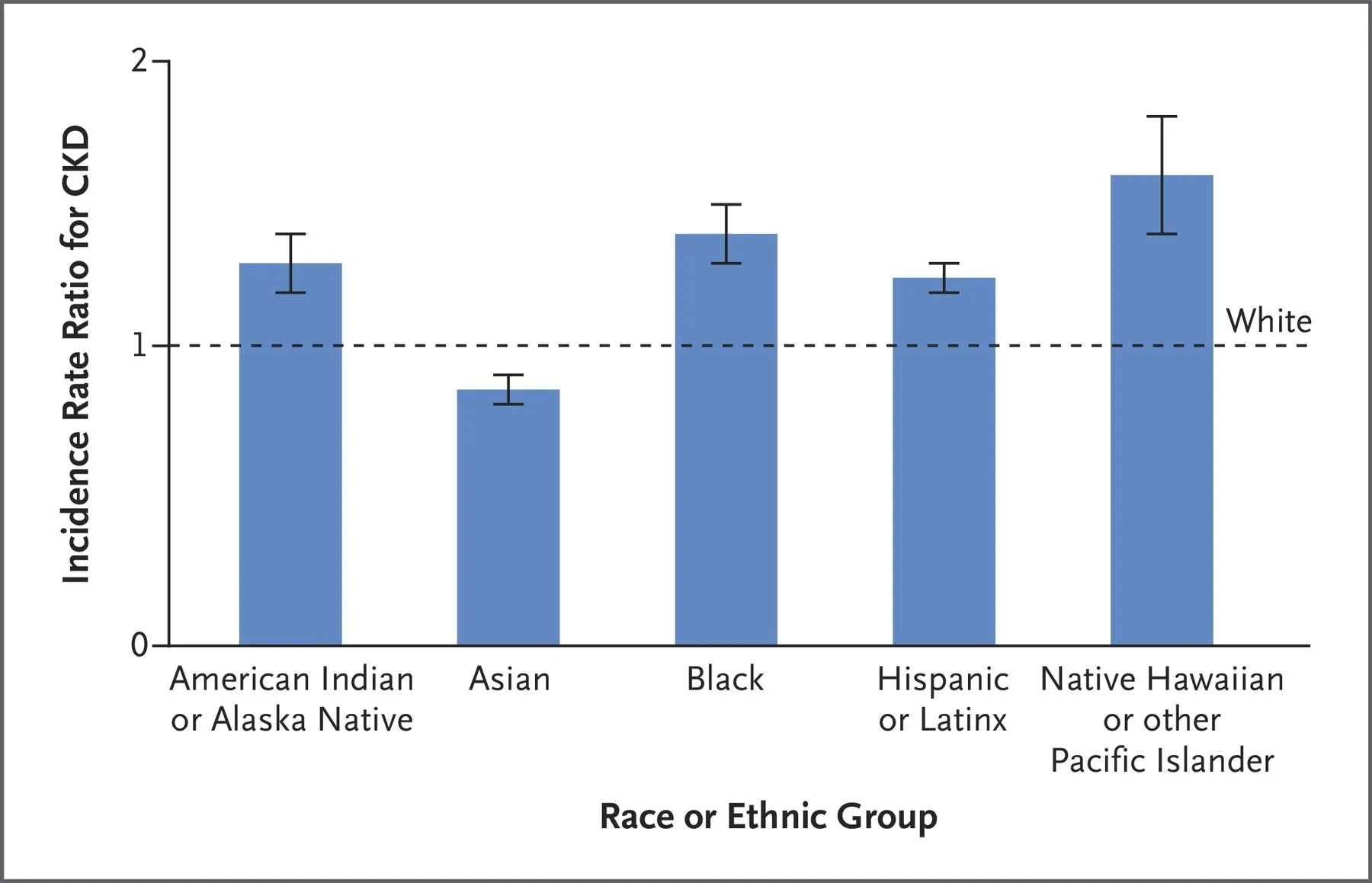
How does diabetes affect our kidneys?
A providence article published in the New England Journal of Medicine highlights a study that reveals an incidence or rate of new worryingly high appearance of chronic renal disease (ERC) in people with diabetes that was more evident in racial and ethnic minority groups.
The prevalence of renal insufficiency that justifies dialysis or transplantation far Duplicate between 2000 and 2019 to almost 800,000 people in the United States, being diabetes the main cause in 47 % of those affected.The incidence of chronic renal disease (ERC) among patients with diabetes is unknown, however, these data are vital to identify high -risk populations, determine the effectiveness of interventions and evaluate the effects on the provision of medical care and responsesof public health.
Figure 1. reasons of ERC incidence rates between patients with diabetes.The incidence rates of chronic kidney disease (ERC) between patients with diabetes, stratified according to race and ethnic group, between 2015 and 2020 are shown. The discontinuous line represents the ratio of incidence rates between white patients (reference group).The analysis was adjusted by age and sex.The bars indicate 95 %trust intervals.
The Middle Ages (± DE) of adults with diabetes in our study population was 61 ± 15 years and 55.2 % were women.
Despite a recent decrease, the persistently high incidence of ERC in the United States is worrying, given the great increase in the prevalence of diabetes and the high rates of renal insufficiency that accompany it.In addition, among patients with early stage, less than 10 % know that ERC has at this point in the course of the disease, when therapies that prevent progression are more effective.Inclusive prevention, detection and intervention strategies are needed to reduce the risk of ERC among people with diabetes.
Our study shows that, despite a recent decrease, a high incidence of ERC persists in the United States.The incidence was lower among white adults with diabetes than among most other adults with diabetes.
Comments
The prevalence of renal insufficiency that requires dialysis or transplantation more than 800,000 people in the United States between 2000 and 2019 with diabetes as the main cause.Previously, the New ERC appearance rate in people with diabetes was unknown, but the value of such incidence data is vital to identify high -risk populations, determine the effectiveness of interventions and evaluate the effects on the provision of medical care andPublic health responses.Even more surprising, less than 10 % of patients with early disease in an early stage know that they have ERC at a time when therapies to reduce progression are more effective.
Providence researchers, the University of California in Los Angeles, the Centers for Disease Control and Prevention and the Faculty of Medicine of the University of Washington carried out a follow -up of 654,549 adults with diabetes between 2015 and 2020 using electronic health records of electronic healthProvidence and the Department of Health of the University of California in Los Angeles, great non -profit health systems that provide services in the west of the United States.
He found that the ERC rates of new appearance were higher in approximately 60 %, 40 %, 33 % and 25 % in the Pacific Hawaii/Isleños native groups, black, American/native Indians of Alaska and Hispanics/Latinos(a), respectively, compared to white people with diabetes.Although the high incidence of ERC persists in diabetes, the rate decreased from 8 % to 6.4% per year in the general population with diabetes between 2015-2016 and 2019-2020.
"Given the rapid growth of the population with diabetes in the United States and the corresponding high rates of renal insufficiency, the persistently high incidence of ERC marked by racial and ethnic disparities is worrying," said Katherine R. Tuttle, M.D., main author of thestudy.Executive Director of Research, Providence Inland Northwest Health and Professor of Medicine, University of Washington."Inclusive prevention, detection and intervention strategies are needed to reduce the risk of ERC in people with diabetes."

10/20/2022 6:44 a.m.
@fer - Diabetes Tipo 1 desde 1.998 | FreeStyle Libre 3 | Ypsomed mylife YpsoPump + CamAPS FX | Sin complicaciones. Miembro del equipo de moderación del foro.
Co-Autor de Vivir con Diabetes: El poder de la comunidad online, parte de los ingresos se destinan a financiar el foro de diabetes y mantener la comunidad online activa.
It affects badly.Very badly.As in everything.

10/20/2022 9:53 a.m.
En 1922 descubrieron la insulina, en 1930 la insulina lenta. ¿Que c*** han hecho desde entonces?
